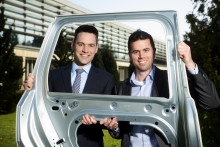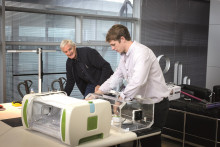Jan Harmen’s PhD was on robust optimization and metal forming processes, and as they sat together they realised together they had the right skills to start a company. The pair started visiting companies as young consultants, and while their consultations on robustness optimization solutions was insightful it was their specialty in talks given about tribology that caught the attention of their customers. In fact, they were on the verge of discovering an open market in the simulation industry.
Johan Hol, Technical Product Manager at TriboForm said:
'People started inquiring after Tribology; and then at a certain moment we were invited as key note speakers at the famous tribology conference TriboForum in Darmstadt. All the big OEM names were present, and this was the real moment TriboForm started, as we received so many requests back then, with many industry leaders asking about our software product. Consequently we decided to change from optimization strategies to Tribology entirely. And as a result we changed our name from Innprove Solutions to TriboForm Engineering. At that time nobody specialized in virtual Tribology at all, we were the first ones on the scene to fill this gap.’
In the world of business leadership TriboForm is a nice example of the blue ocean strategy working at its best. TriboForm officially started in 2013. Accordingly at that time Johan Hol and Jan Harmen Wiebenga only worked on TriboForm one day per week, being paid for consulting projects. After finishing their PhD’s they went full steam ahead in building TriboForm.
An 'aha moment'
Their previous consulting network paid off as they continued to gain momentum and increasingly got invited to speak about Tribology. ‘At that time it was all new for our customers, they didn’t even know that they had a problem’ says Hol. The industry faced an ‘aha moment.’

The traditional approach was to do manual testing by running several experiments in order to determine the ‘best’ friction coefficient under different conditions. Yet admittedly many engineers knew that they ought to be using something other than a fixed value for friction.
The story of TriboForm continued when demand grew, as companies started outright wanting to see the actual effects of adjusting the friction coefficient by applying the TriboForm model and how it would affect their simulations. Amazingly the startup pulled all of this off without even having a product! They offered what they called the TriboForm Solver, which in 2015 was a working methodology.
But the problem was customers wanted to do it all themselves. They didn’t want consultants to demonstrate the influence of tribology on their own processes. In response TriboForm developed a solution: the TriboForm software package, being the TriboForm Analyzer and the TriboForm plugin for AutoForm, LS-Dyna and Pam-Stamp.
TriboForm Friction Model
Now, using this software customers can select a tribology system and export it as a file. Thanks to the TriboForm plugin this file can be imported and used in e.g. AutoForm, entirely replacing the outdated approach of using a fixed coefficient of friction. This new variation is called the TriboForm Friction Model which is a vast improvement on the scene.
When applied to simulation the geometries of the tool come from AutoForm. Then the model incorporates the roughness of the sheet material, the lubricant and tooling as a cohesive whole in action. In simple terms if you were to zoom into sheet material you’ll see what appears to be valleys and mountains, which amounts to the ‘roughness’ factor, and this information is utilized by TriboForm to calculate friction during stamping.
Fast forwards to today, TriboForm has established itself on the market as a serious force to be reckoned with, and has brought serious change to industry practices, especially for die stamping.
In the world of simulation it is a Bill Gates, Google and Steve Jobs story. With just seven staff members the team is young, vibrant and very motivated about building the software they have.







